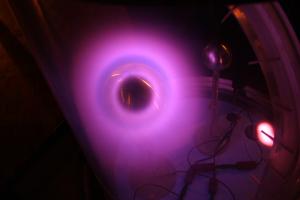Blog
Electric Boogaloo
31 July 2014
 Wikimedia
WikimediaDark matter is one of those things in astrophysics that lots of people have trouble accepting. After all, the “experts” claim that since their gravitational models don’t agree with observation, there must be some invisible, undetectable “stuff” that isn’t regular matter. It just seems so counter-intuitive.
As I’ve noted before, the idea of dark matter isn’t invoked just to make the standard theories work. Despite our incomplete understanding of dark matter, there is significant evidence to support it. But how do we know that regular matter isn’t enough to account for the unseen mass in the universe? What if it were something like dark mode plasma?
Dark mode plasma (sometimes referred to as Birkeland currents) is an idea that mainly appears in electric universe (EU) discussions. It has some connection to traditional plasma physics, but if you Google “dark mode plasma” you mainly get references to EU sites. The basic idea is that with currents running through plasmas in the lab, you have regions where the current is strong enough to cause the plasma to emit light (glow mode), while in other regions the current is not strong enough to cause light emission (dark mode). Since the dark mode plasma doesn’t emit light, it is essentially invisible. So couldn’t it play the role of “dark matter” without some mythical exotic material.
I’ve gotten a few emails recently from EU fans making exactly that claim. As I’ve discussed before, the electric universe doesn’t really agree with observational evidence, so it would be easy to simply dismiss the idea. But I find the idea kind of interesting. After all, how do we know that we’ve accounted for all the regular matter in the Milky Way? The usual argument is that galaxies such as ours don’t just have a small amount of “missing” mass, but rather about 95% of the mass is “missing.” If 95% of the Milky Way’s mass were simply cold and dark gas and dust, it would absorb so much light that we would clearly see its effect. So what about plasma?
At at a basic level, if you had a plasma made of fully ionized hydrogen, you would simply have a sea of freely moving electrons and protons. Atoms absorb light when an electron in an atom is kicked into a higher energy orbital, and they emit light when an electron drops into a lower energy orbital. Since the electrons are not “bound” to the protons in a plasma, this can’t occur. Since light (particularly light in the visible spectrum) isn’t emitted or absorbed by the plasma it is basically invisible. This is starting to sound a lot like dark matter!
But since the protons and electrons are electrically charged, they still interact with light. A stream of photons passing through a plasma can still be scattered by the protons and electrons, and this is where things get interesting. The amount of scattering you get depends upon the wavelength of the light, so if shine a brief pulse of light through a plasma, you get a dispersion of the pulse due to its interaction with the plasma. This is similar to the way glass spreads out a pulse of light by frequency. The speed of light passing through glass (or the index of refraction) is slightly different for each color, so the pulse is spread out a bit. For light and glass, the effect is small, so we don’t normally notice it, however it’s this same effect that lets prisms break light into colors.
This effect has been seen in the lab with plasmas, but it has also been observed within our galaxy. The radio signals from pulsars occur as a short pulse of light. Since there is plasma between us and a pulsar (the interstellar medium) the pulse must therefore pass through this plasma to reach us. That means we can use pulsar signals to learn about the plasma between us and the pulsar. For pulsar pulses and galactic plasma, the effect is dramatic. The radio pulse travels for light years, so there is much more time for it to spread by frequency. So instead of a simple radio pulse, we see the higher frequencies reach us a bit sooner than the lower frequencies. This spread is known as the dispersion measure (DM), and it depends on the amount plasma between the radio source and us. So the DM of radio signals lets us determine how much ionized gas there is in the galaxy.
There are lots of pulsars through our Milky Way Galaxy. By observing the DM of these pulsars we can create a map of the plasma within our galaxy, so we have a really good idea of just how much “dark plasma” there actually is. It turns out there isn’t nearly enough to account for the “missing mass” in our galaxy.
So dark mode plasma is an interesting idea, but it can’t work as a substitute for dark matter.